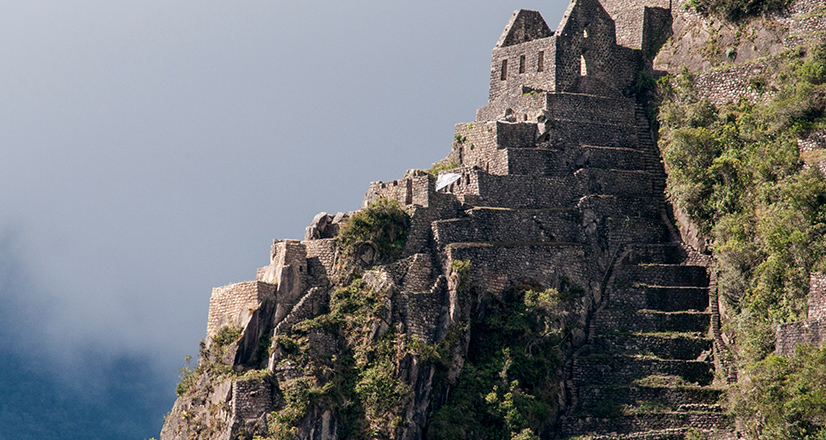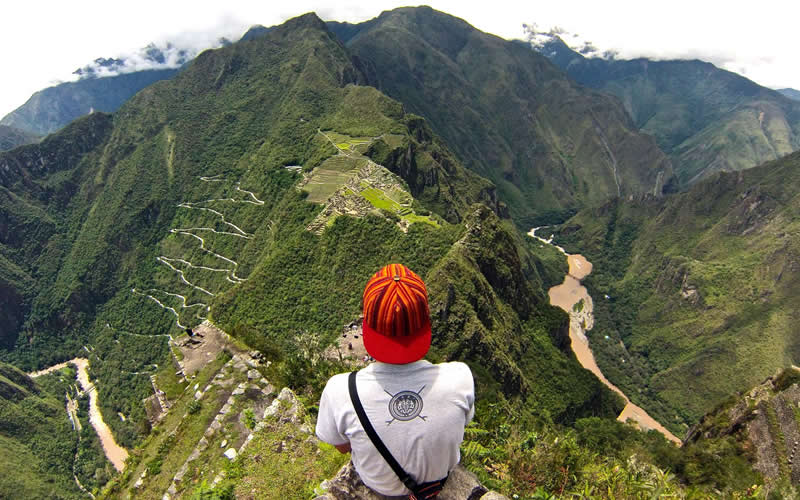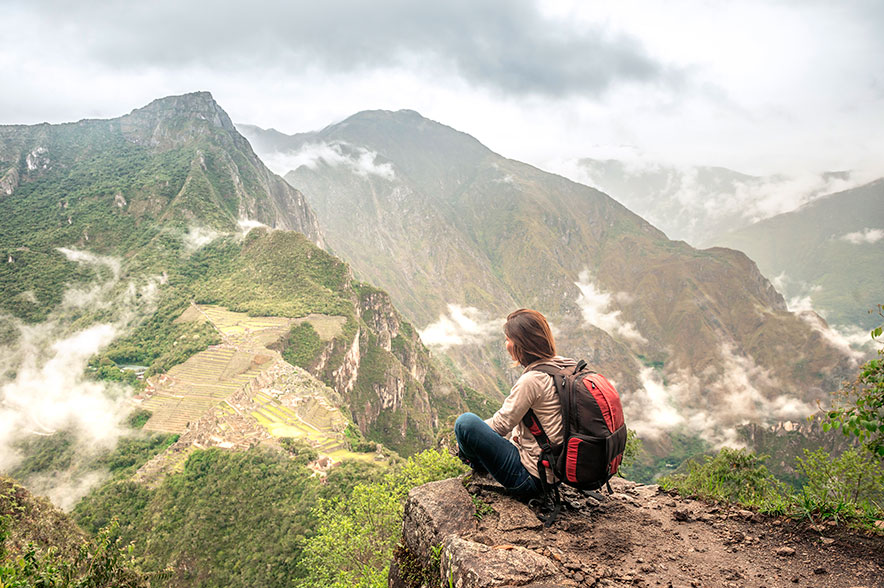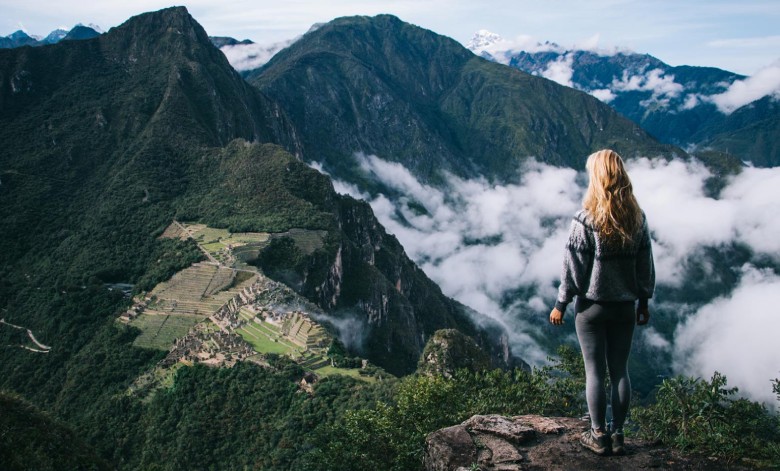Huayna Picchu, often referred to as the ‘Young Peak’, stands as a towering testament to the ingenuity and spirit of the Inca civilization. This majestic mountain, rising over 2,720 meters (8,920 feet) above sea level, is perched above the renowned archaeological site of Machu Picchu in Peru, offering breathtaking views of the ruins and the surrounding Andean landscape.
Known for its steep and narrow paths, including sections with original Inca stairs, Huayna Picchu presents a challenging yet rewarding hike for those adventurous enough to ascend its peak. At its summit, adventurers are not only rewarded with panoramic vistas but also encounter remnants of Incan architecture, including terraces and temples that hint at its historical significance. The journey to Huayna Picchu is more than a physical challenge; it’s a pilgrimage through time, offering a unique glimpse into the heart of Incan culture and its harmonious relationship with nature.

The imposing Huayna Picchu
A bit of history
The history of Huayna Picchu is deeply intertwined with that of Machu Picchu, the iconic Inca city it overlooks. Believed to have been constructed in the mid-15th century under the reign of Inca emperor Pachacuti, Machu Picchu served as a royal estate nestled between the Andean Mountain Range. Huayna Picchu, with its strategic location and daunting slopes, played a crucial role in the city’s defense system and religious significance.
Archaeological evidence suggests that the peak of Huayna Picchu was used as a high-altitude shrine, a testament to its spiritual importance to the Inca people. The narrow paths and terraces carved into its rocky face were not only feats of engineering but also sacred spaces, with the Temple of the Moon—one of the most significant structures on the mountain—serving as a prime example of Incan architectural skill and their reverence for natural landscapes.
The Inca trail leading to the summit of Huayna Picchu was a pilgrimage route for Inca nobility, symbolizing a spiritual journey towards the heavens. The fact that only a limited number of people were allowed to ascend the peak each day reflects its exclusivity and sacredness. Following the Spanish conquest in the 16th century, Machu Picchu and its surrounding peaks, including Huayna Picchu, were abandoned and gradually reclaimed by the dense cloud forest, hiding them from the outside world until their rediscovery in 1911 by Hiram Bingham.
Today, Huayna Picchu stands as a monument to the Inca’s architectural and spiritual legacy, offering modern-day visitors a tangible link to the past and an unparalleled view into the world of one of history’s most remarkable civilizations.
Let’s Hike the Huayna Picchu!
To hike Huayna Picchu, the iconic peak that looms over the ancient Incan city of Machu Picchu in Peru, you’ll need to plan ahead and follow several steps due to its popularity and the limited number of visitors allowed each day. Here’s how you can embark on this breathtaking adventure:
Purchase Your Ticket
First and foremost, you need to buy a ticket that specifically includes access to Huayna Picchu. Tickets to Machu Picchu and Huayna Picchu are often sold together and are available through the official Machu Picchu ticketing website or through authorized tour operators. It’s crucial to book well in advance, as only 400 hikers are allowed to ascend Huayna Picchu daily, divided into two groups of 200 each, one starting at 7:00 AM and the other at 10:00 AM.
Plan Your Visit
Decide on the date and time slot for your hike. Consider the two available time slots and choose based on your preference for an early start or a later climb. Remember, the weather can be quite variable, with mornings often misty, which can clear up to reveal stunning views as the day progresses.
Arrive Early
On the day of your hike, make sure to arrive at the entrance of Machu Picchu early, as you’ll need to check in for the Huayna Picchu hike at a specific checkpoint before starting your ascent. This is also to ensure you have enough time to reach the checkpoint before your designated time slot.
Prepare for the Hike
The hike is challenging and includes steep, narrow paths and sections with old Incan staircases. Proper hiking shoes, water, snacks, and a good level of fitness are recommended. Additionally, consider bringing a rain jacket, as the weather can change quickly.
Follow the Path
The trail is well-marked, leading you through breathtaking scenery, ancient Incan ruins, and terraces carved into the mountain’s side. The ascent typically takes about 1.5 to 2 hours, while the descent takes a bit less time. Upon reaching the top, you’ll be rewarded with incredible views of Machu Picchu and the surrounding Andean mountains.
Respect the Site
Remember to respect the archaeological site by staying on marked paths, not removing any stones or artifacts, and carrying out all trash. This helps preserve the site for future generations.
Consider a Guide
While not mandatory, hiring a guide can enhance your experience by providing historical context, pointing out lesser-known sights along the way, and ensuring you don’t miss any highlights.

A fantastic viewpoint in the Huayna
By following these steps and preparing adequately, you’re set for an unforgettable journey up Huayna Picchu, offering not only a physical challenge but also a deeper connection with the history and culture of the Incan civilization.
Some curious facts about Huayna Picchu
Huayna Picchu, the iconic peak that towers above Machu Picchu, is shrouded in both mystique and allure. Here are some curious facts about this remarkable landmark:
- Exclusive Access: Huayna Picchu limits its visitors to just 400 per day, divided into two groups. This exclusivity makes securing a spot a competitive endeavor, highlighting the peak’s special status among travelers and history enthusiasts alike.
- Ancient Staircase: One of the most nerve-wracking parts of the hike is the “Stairs of Death,” a steep and narrow staircase carved directly into the rock. Although the name sounds ominous, they offer an exhilarating climb with spectacular views, and, with careful navigation, are safely traversable.
- Hidden Temple: Near the summit lies the Temple of the Moon, an exquisite example of Incan craftsmanship. This lesser-known site is carved into a natural cave, demonstrating the Incas’ advanced masonry skills and their reverence for natural and celestial elements.
- Archaeological Enigma: Despite its fame, much about Huayna Picchu remains a mystery, including the exact purposes of its structures. Some theories suggest they served as a lookout post or a religious shrine, highlighting the peak’s significance in Incan culture.
- A Botanist’s Dream: The area around Huayna Picchu is home to a diverse range of flora, including several species of orchids and the unique Puya raimondii, a giant bromeliad that can grow up to 10 meters high. This biodiversity adds an extra layer of beauty to the challenging hike.
- Symbol of Harmony: Huayna Picchu and Machu Picchu together symbolize the Incan civilization’s harmony with nature. The Incas built their structures to blend seamlessly with the surrounding landscape, respecting and emphasizing the natural beauty of the Andes.
- A Photographer’s Paradise: The view from the summit of Huayna Picchu offers one of the most iconic perspectives of Machu Picchu, with panoramic shots that capture the imagination of photographers and travelers worldwide. The early morning mist and the play of light and shadow over the ruins create a magical atmosphere that is almost ethereal.
These facts only scratch the surface of the mystery and allure that Huayna Picchu holds. Its combination of natural beauty, architectural genius, and historical significance makes it a captivating destination for those lucky enough to visit.

A must-see view
Huayna Picchu stands as a poignant symbol of the Inca’s legacy, its pathways weaving through time, leading adventurers to the heart of ancient wonders. This climb is more than a journey; it’s an emotional ascent into the past, connecting each step to the soulful echoes of the Andes. Reaching its summit transcends physical achievement, offering a profound communion with history and the breathtaking majesty of nature. In the embrace of Huayna Picchu, one finds not just panoramic views but a deep, resonant connection with the indomitable spirit of the Inca civilization, forever etched in stone and memory.
We hope you liked this travel blog, if you have any questions or suggestions feel free to comment! Great day to you!
Another interesting blogs:
- Perolniyoc’s Secret: A Nature’s Masterpiece
- Unlocking the Secrets of Qorikancha: The Golden Temple of the Sun
- Cusco’s San Pedro Market: Flavors and Colors of Tradition
- Beyond the Stones: The Vibrant Spirit of Ollantaytambo

